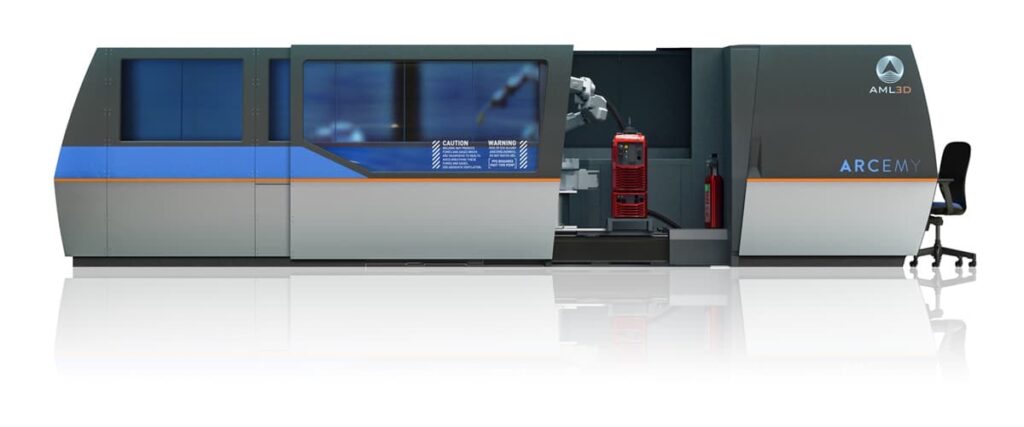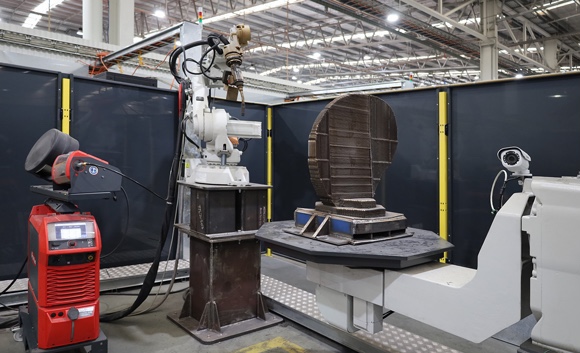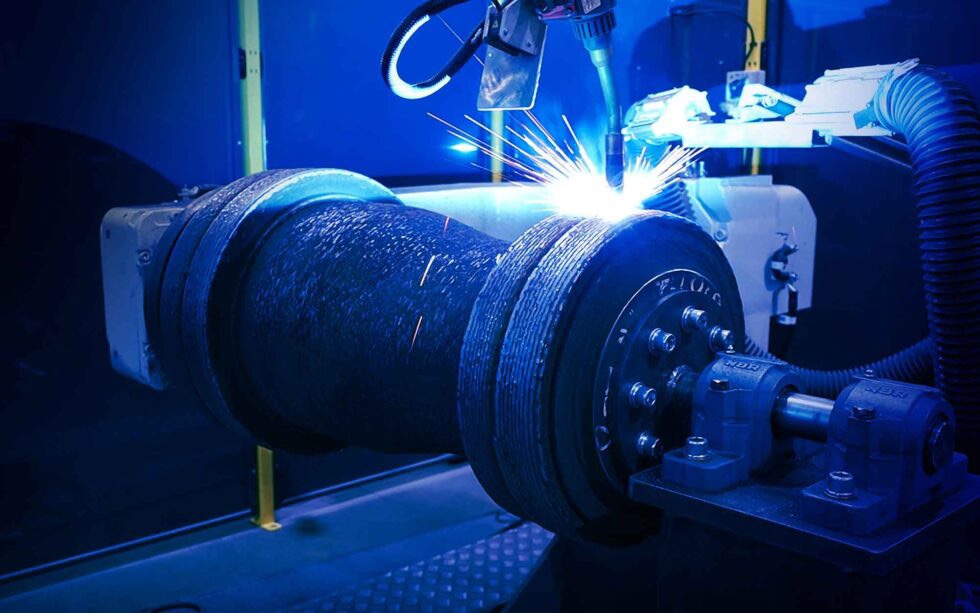AML3D Evolves from Contract Manufacturer to 3D Printer OEM: An Interview with Interim CEO Sean Ebert
It’s never easy for a company to reinvent itself, especially regarding strategy—performing tweaks not only to individual details, but to an organization’s entire overall mission. Nevertheless, sometimes opportunities present themselves that can make the potential reward outweigh the risk.
AML3D, a wire arc additive manufacturing (WAAM) firm headquartered in Adelaide, Australia, is currently in the process of executing a major strategic shift in response to just such a commensurate opportunity. Specifically, that opportunity is the scale-up potential inherent in the US defense industrial base’s growing demand for the full gamut of digital manufacturing equipment.
I recently spoke with Sean Ebert, the company’s Interim CEO, about AML3D’s transition from a focus on contract manufacturing to its new primary identity as an original equipment manufacturer (OEM). Although the company, founded in 2014, is maintaining its presence in the oil & gas sector — its traditional bread-and-butter on the service side of things — the new center of its attention is the U.S. Navy, via which AML3D is hoping to rapidly expand and solidify its entrance into the Department of Defense’s (DoD’s) broader supply chain.

New CEO, New Business
The company recently sold its ARCEMY X-Edition 6700 platform to Oak Ridge National Laboratory (ORNL), which will be used by the institution to develop solutions for U.S. submarine production. As noted in a recent press release about the company’s progress thus far in 2023, “AML3D has a very clear focus on our OEM supplier strategy; scaling up our presence in the US Defense sector by supporting the US Navy submarine industrial base, in the first instance.”
Although Ebert may have only recently stepped into the Interim CEO role, he has been a member of the Board of AML3D and involved in the AM industry for almost four years. Ebert knows the submarine market in the U.S. is easily one of the most promising spaces on the planet right now for an AM company looking for the rare combination of quick and enduring growth.

“I brought over 20 years of executive and Board level experience across oil and gas, mining and resources and emerging technologies with me when I joined the Board of AML3D in 2019” Ebert, who has an engineer’s eye for detail and a director’s capacity for big-picture strategy, told me. “So I was more than happy to step in and lead a leading edge manufacturing technology company like AML3D. I know it might sound clichéd but one of the things that gets me out of bed every day is tech, particularly stuff that’s disruptive or has an opportunity to create value somewhere in the supply chain.”
As AM matures, more and more executives are entering the sector from other industries. While there is certainly a learning curve for new executives involved in this process, I think it will ultimately prove to have quite positive outcomes for AM’s ability to be a profitability engine. It is, perhaps, precisely the fact that Ebert is able to approach a market comprised of promising, yet still relatively untested, technologies with a breadth of experience in other and, at a times, related industries, that makes him such a fitting individual to guide AML3D through its pivot to supplying the US Defense and Marine industrial based and, consequently the appointment process for a US centric CEO.
Large-scale WAAM
“When I was approached to consider the Interim CEO role I was more than happy to take it on. I knew AML3D has a compelling advantage in its tech stack,” Ebert explained. “AML3D has a unique, industrial scale, metal 3D printing technology that is going to enable the company to fight for and win market share in a global world of 3D printing technologies. We may be based out of Adelaide in Australia, on the other side of the world, but our technology can quickly and easily be deployed anywhere on the planet.”
Ebert continued, “Happily, as I carried out my own research and due diligence prior to joining the AML3D board in 2019, I worked out pretty quickly that in that continuum of 3D printing, we occupy a small component of that, which is wire additive. So, for one thing, we operate in an open-air environment. We’re not confined by the constraints of a small glass box environment. That gives us a number of advantages, but particularly on the size of the parts that we can manufacture.”

Pressure vessel printed for ExxonMobil
That rather straightforward consideration of build capacity is probably the key factor shaping the growing interest in AM on behalf of both the oil & gas and defense markets. In turn, this does much to explain the AM sector’s drive in the last several years towards the development of larger and larger metal platforms.
The connection between the two markets on that front has likely been beneficial to the ongoing development of materials for both spheres, as qualification of metals is an absolute necessity for an AM company hoping to gain a foothold into those strictly regulated supply chains. AML3D has an extensive familiarity with the metals qualification process. The company met the American Petroleum Institute (API) Standard 20S with the pressure vessel it delivered to ExxonMobil last year, and is currently working on gaining its AS9100D certification, for producing parts in the aerospace sector. Additionally, AML3D’s recently announced contract to qualify metal parts for the U.S. Navy’s submarine program has now successfully moved into the testing phase.
Oil and Gas and DoD Supply Chains

Ebert also pointed me to another connection between those two enormous markets (defense and oil & gas) that is not technological in nature but is purely related to the day-to-day logistics that intertwine separate but overlapping supply chains. The Interim CEO made an extremely useful comparison between the overall structures of the military and oil sectors, a comparison that is applicable to every area of heavy industry:
“The way we think of the [DoD], and the U.S. Navy in particular, or any of the big defense pillars, is that they’re at the center ring of an onion, and outside that ring there are prime contractors and there are subcontractors, and we’ll probably be selling our machines into that ecosystem of subcontractors that are contracting to the primes. Some machines might go to the primes. I think that’s no different from the oil & gas industry as well, as a model. There are the supermajor oil producers in the center ring, and outside of that ring are large prime contractors, oil field service companies, etc. And I think we’ll sell those machines into those subcontractors and oil field services companies that are providing parts for the large oil and gas majors.”
Rebuilding Manufacturing Centers
In the last couple of decades, the pool of relevant subcontractors — the outermost ring of the onion — in the U.S. has been decimated, accounting for much of the ongoing general supply chain chaos across the globe. Manufacturing subcontractors comprise the area of the economy most specifically targeted by Biden’s AM Forward initiative, a policy which Ebert fully grasps the significance of.
Referring to AM Forward, along with other U.S. policies related to accelerating the nation’s advanced manufacturing capabilities, Ebert said, “There’s obviously a big push to rebuild sovereign capability in the U.S. which is in decline, or depleted—whichever adjective you want to use, following NAFTA and globalization.”
He pointed out that the same goes for Australia, albeit on a less grandiose scale: “In Australia, to a much smaller extent, we are also pushing heavily for sovereign capability. We’re a much smaller market, so we need to rely on partners in the region for various things. …But there is a push here. I think the sovereign capability thing lends itself really nicely to trying to protect those supply chains from future shocks like another pandemic. [Again,] the oil & gas sector is a great example of that. One of the reasons oil & gas is so interested in additive is trying to ensure that they’re not disrupted or put in a risky, precarious position, not able to get the parts they need on time, like during COVID.”
Along these lines, AML3D’s shift in strategy is both possible and necessary because of all the overlapping issues that have been faced in the last few years, by the sectors that manufacture the largest and heaviest parts. And, more precisely, the shift in strategy is possible and necessary because of how those sectors are addressing the problem.
“Supply chains are frustratingly hard to fix and to speed up,” Ebert summarized. “Imagine some traditional manufacturing operation that existed in Illinois or around the Detroit area, for instance, in the seventies and eighties and early nineties, and that’s disappeared. All of those skills, all of that know-how, all of that intellectual property — not just the capital investment — to reestablish that is gone. So, you might find, you know, $4 billion to rebuild all of that, but where are you going to staff it? How are you going to? Where are the educated skills going to come from to man those factories?…Almost the only way to fix that short of rebuilding these old traditional manufacturing operations is to look to advanced manufacturing, which is less skill-heavy, there’s far more robotics, and the types of skills are in relative supply.”
Thus, the U.S.’s snap decision to rebuild the defense industrial base to whatever extent it could, as quickly as it could, means that contract manufacturers now have virtually infinite more competitors to contend with than they did previously. At the same time, because of that exact same catalyst, OEMs in the AM space can now expect the emergence of an unprecedentedly large quantity of new potential customers.
AML3D, then, not only made the correct decision by adapting its strategy. It also made that decision and started executing on it in about the shortest timeframe imaginable. Many other companies can be expected to try to make similar changes in years ahead, but this is certainly a situation where being at the front of the line will make a difference.
Images courtesy of AML3D
Subscribe to Our Email Newsletter
Stay up-to-date on all the latest news from the 3D printing industry and receive information and offers from third party vendors.
You May Also Like
Further Understanding of 3D Printing Design at ADDITIV Design World
ADDITIV is back once again! This time, the virtual platform for additive manufacturing will be holding the first-ever edition of ADDITIV Design World on May 23rd from 9:00 AM –...
3D Printer Maker EVO-tech Reborn as NEVO3D — Once More With Feeling
EVO-tech was a 3D printing service and original equipment manufacturer established in 2013 and based in Schörfling am Attersee, Austria. The company produced high-quality material extrusion systems featuring linear bearings,...
3D Systems Brings 3D Printed PEEK Cranial Implant to the U.S. with FDA Clearance
For more than 10 years, 3D Systems (NYSE:DDD) has worked hand-in-hand with surgeons to plan over 150,000 patient-specific cases, and develop more than two million instruments and implants from its...
CDFAM Returns to Berlin for Second Annual Symposium
The second CDFAM Computational Design Symposium is scheduled for May 7-8, 2024, in Berlin, and will convene leading experts in computational design across all scales. Building upon the first event...































